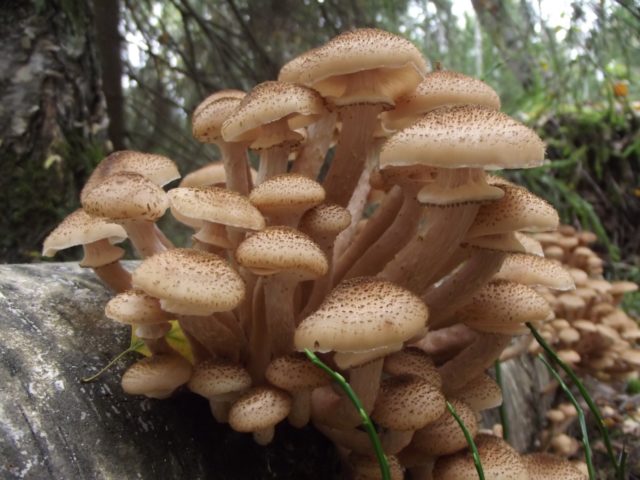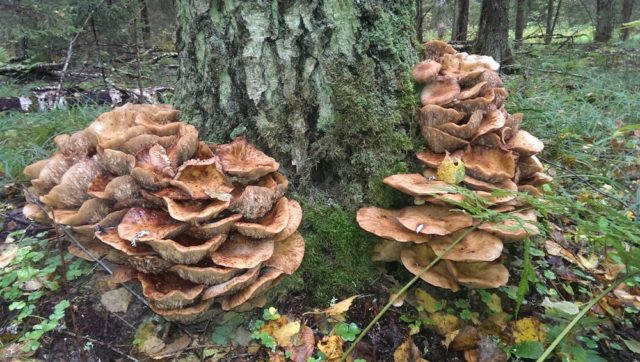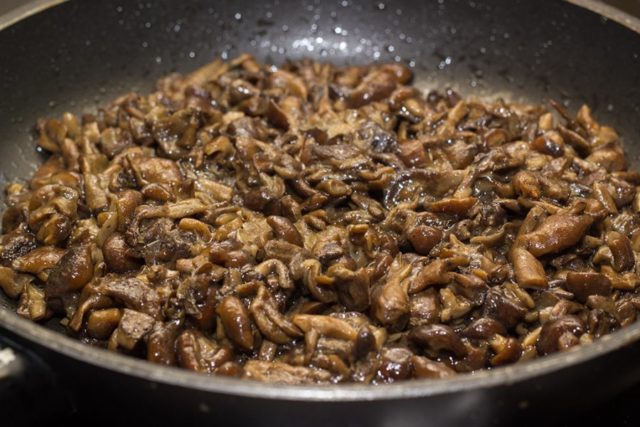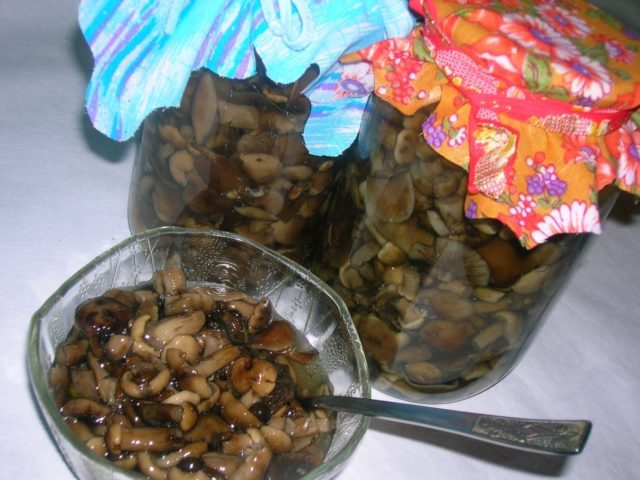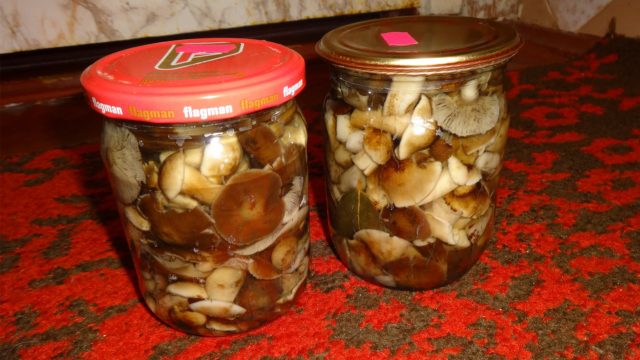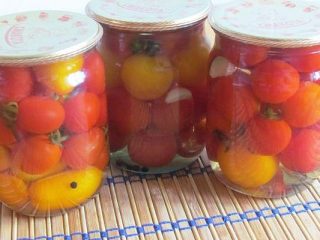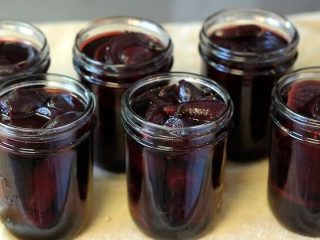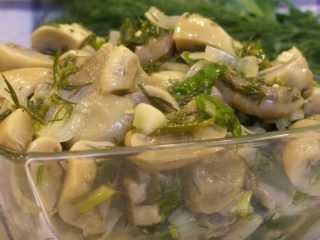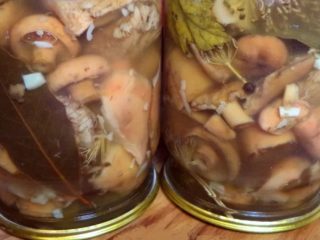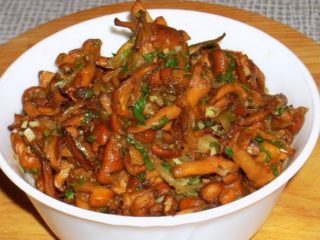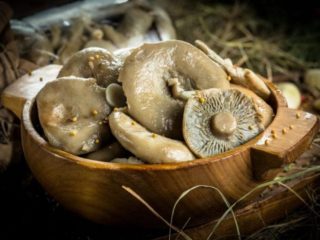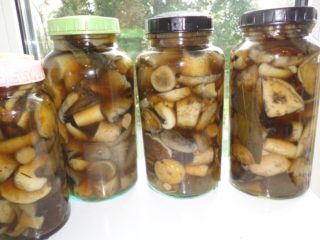Content
Lovers of walks in the forest often encounter overgrown honey mushrooms that grow in groups along with young individuals. Many novice mushroom pickers do not know whether they can be collected and what dishes are prepared from overgrowths.
What do old honey mushrooms look like?
Autumn honey mushrooms are agaric mushrooms that grow in coniferous and deciduous forests. They are found in large quantities; you can get a whole basket from one stump. They got their name due to the arrangement of rings around the remains of trees. In one place you can find both young individuals and overgrown honey mushrooms.
To learn to recognize overgrown autumn mushrooms, you need to know the appearance of young mushrooms. The cap of the young mushroom body is hemispherical, 2-7 mm in diameter, pink, beige or brown. The top of the cap is covered with scales of a darker tone. The plates are whitish in color, the flesh is white, tender and elastic. The leg is long, thin, 10-15 cm long.By the presence of a skirt on the stem of young fruiting bodies, they are distinguished from false ones.
With age, the cap of the overgrown fruit straightens and takes on the shape of an umbrella, rounded at the edges. The scales disappear and the color of the cap darkens. It becomes smooth and loses its moist oiliness. The legs become longer, the characteristic skirt is barely noticeable or disappears. The pulp of the overgrowth turns brown and becomes tougher and more fibrous. The aroma weakens. The photo shows that overgrown honey mushrooms differ significantly from young ones.
In overgrown mushrooms, spores often leave their container and land on the caps of neighboring mushrooms.
Is it possible to collect overgrown honey mushrooms?
Despite the loss of attractiveness, old autumn mushrooms are quite edible. The fruiting bodies grow quickly, preserving the beneficial and tasteful qualities of young mushrooms.
Not all specimens should be collected. Some of the overgrowths turn black and become moldy. The lamellar layer crumbles in places, the legs become thin, and the overgrown mushroom takes on a rotten appearance. Such fruits should not be collected; you cannot be poisoned by them, but when eaten, they leave a bitter aftertaste.
Overgrowths with a strong fruiting body without signs of damage or worminess are suitable for collection. Clean, overgrown honey mushrooms can be safely collected; they are no less tasty than young mushrooms.
For old autumn mushrooms, only the caps are used. The legs become hard and fibrous. It’s better to get rid of them right in the forest so as not to carry extra weight home.
The collection site should be located away from highways and production areas due to the ability of mushroom pulp to absorb harmful fumes of heavy metals.
How to cook old honey mushrooms
Overgrown honey mushrooms can be dried, boiled, salted, fried, pickled. There is no need to be afraid to use overgrown honey mushrooms. Dishes with them are not inferior in taste and nutritional value.
Overgrown mushrooms need to be properly cleaned. The caps are checked for the presence of worms, dark areas and spore-bearing plates are removed. The peeled fruiting bodies are soaked for 1 hour in salty cold water (1 tablespoon per liter of liquid). Change the water three times; overgrowths may taste a little bitter. Properly processed overgrown honey mushrooms can be safely eaten.
How to cook overgrown honey mushrooms
Honey mushrooms are a perishable product. The maximum time before the start of processing is about a day. It is advisable to carry it out immediately after returning from the forest. The overgrowths are sorted out, freed from debris, and washed thoroughly. Large caps are cut into four parts. Overgrown honey mushrooms are cooked as follows:
- Bring lightly salted water to a boil in an enamel saucepan.
- Place the prepared slices and cook for 10 minutes, periodically removing the foam.
- Drain the overgrown mushrooms in a colander and rinse. They put it back to boil in clean water. Add salt to taste.
- Cook for 30-40 minutes until the mushrooms sink to the bottom.
- Place in a colander and rinse thoroughly with water.
Honey mushrooms can be frozen. In this form, they retain their texture, taste, aroma and beneficial properties.
Before packaging, the overgrowths are blanched:
- Take two enamel pans. One is placed on the fire with salted water (1 tablespoon of salt per 1 liter of water), the second is filled with water and ice.
- Dip mushrooms into boiling water for 2-3 minutes.
- Drain the overgrowths in a colander, then transfer them to a saucepan with ice for quick cooling.
- To cool completely, place on a napkin.
Cooled, dried fruiting bodies are placed in plastic containers or small bags.
How to fry old honey mushrooms
Fried overgrown honey mushrooms are the most popular recipe. You can fry fruit bodies either with or without preliminary boiling. In this case, the overgrowths are thoroughly washed with running water and simmered in a frying pan until the moisture has completely evaporated.
Frozen honey mushrooms are placed in a well-heated frying pan with oil without prior defrosting.
Fried overgrown honey mushrooms with onions
Ingredients:
- honey mushrooms - 1 kg;
- onions - 2-3 pcs.;
- butter – 30 g;
- salt, herbs to taste.
Preparation procedure:
- Peeled and washed mushrooms are boiled for a quarter of an hour.
- Onions, cut into half rings, are fried in butter.
- Boiled mushrooms until half cooked are added to the frying pan, salted, peppered, and simmered for 20-25 minutes.
- When serving, the dish is sprinkled with chopped herbs.
Fried honey mushrooms with mayonnaise
Ingredients:
- overgrown honey mushrooms - 1 kg;
- vegetable oil - 2 tbsp;
- onions - 2-3 pcs.;
- mayonnaise - 2 tbsp. l;
- greens to taste.
Preparation procedure:
- The overgrowths are boiled until half cooked, adding a small amount of citric acid.
- Onions are cut into half rings and fried in a frying pan.
- Combine mushrooms with fried onions, add chopped garlic, salt and pepper to taste. Simmer for 20 minutes over medium heat.
- 5 minutes before readiness, add mayonnaise.
- The dish is served with chopped green onions or basil.
Preparations from overgrown honey mushrooms for the winter
The collection season lasts from late August to early October.Autumn is a convenient time to harvest overgrown honey mushrooms for the winter. They can be dried, salted, pickled, or made into mushroom caviar.
Pickled overgrown honey mushrooms
Ingredients:
- overgrown honey mushrooms - 1 kg;
- vinegar 70% - 1 tbsp;
- vegetable oil - 3 tbsp. l.;
- sugar, salt - 1 tbsp. l.;
- peppercorns, cloves - 3 pcs.;
- bay leaf - 1 pc.;
- garlic, nutmeg to taste.
Preparation procedure:
- The sorted and washed fruiting bodies are soaked for 2 hours in cold water.
- Boil in salted water for 30 minutes, skimming off the foam.
- When the overgrowths sink to the bottom, they are thrown into a colander.
- Place the prepared spices in 1 liter of water and cook the marinade for 3-5 minutes, adding the essence at the end of cooking.
- Sterilize glass jars and metal lids.
- Finely chop the garlic.
- Place mushrooms into the boiling marinade and cook for 15 minutes.
- Place in jars along with the marinade and add garlic.
- Pour a layer of hot vegetable oil on top.
- Roll up the jars with metal lids.
Mushroom caviar from overgrown honey mushrooms
Low quality overgrowths are suitable for preparing mushroom caviar: broken, old, with legs. Some mushroom pickers make caviar from just the legs.
Ingredients:
- fresh honey mushrooms - 3 kg;
- vegetable oil - 200 ml;
- onions—5 pcs.;
- salt to taste.
Preparation procedure:
- Well-washed overgrown mushrooms are boiled for 20 minutes.
- The onions are peeled and passed through a meat grinder along with honey mushrooms.
- Heat the frying pan well, pour out some of the oil, add ground sprouts and onions.
- Simmer until the liquid has completely evaporated for about half an hour.
- Place in sterilized jars and pour boiling vegetable oil on top.
- Cover with lids and store in the refrigerator.
The snack can be stored in the refrigerator for 5-6 months. You can freeze caviar by placing it in plastic bags. When storing in the cellar, jars should be closed with metal lids.
Recipes for pickling old honey mushrooms for the winter using hot and cold methods are very simple. In the first case, the appetizer will be ready in 1-2 weeks; with the cold salting method, readiness occurs in 1-2 months.
Salting overgrown honey mushrooms using the hot method
Only strong, undamaged fruiting bodies are suitable for this preservation method.
Ingredients:
- honey mushrooms - 2 kg;
- salt - 150 g;
- garlic - 3-4 cloves;
- peppercorns 15 pcs.;
- currant leaves, cherries, chopped horseradish leaves.
Preparation procedure:
- Cleaned and washed overgrowths are boiled for 20 minutes, periodically removing the foam.
- Drain in a colander and place on a napkin.
- Some of the salt and spices are placed at the bottom of sterilized jars. Lay a layer of honey mushrooms with the caps down. Cover with a layer of salt and herbs, then again a layer of mushrooms.
- Fill with broth to the very top, excluding air bubbles.
- The jars are closed with plastic or screw caps and stored in the basement.
Cold salting
Ingredients:
- overgrown honey mushrooms - 4 kg;
- salt 1 tbsp;
- peppercorns bay leaf - 10 pcs.;
- dill umbrellas, cherry and currant leaves.
Preparation procedure:
- A three-liter jar is sterilized.
- Layer layers of greens with salt and spices, then overgrown honey mushrooms to the top of the jar.
- Place a clean cloth on top in several layers, apply pressure, and place it in a cool place.
- After the mushrooms have settled, additional layers are added until the jar is completely filled.
- Cover with a tight polyethylene lid.
A basement with a temperature of +6-+8˚С is suitable for storing pickles; in such conditions, the preparations can be stored from 6 months to a year (prepared using the hot method). At temperatures above +10˚С, mushrooms sour and lose their taste.
Useful tips
When going for honey mushrooms, you need to choose a mixed forest, where there is a lot of windfall and fallen trees. Honey mushrooms often grow in clearing areas and clearings.
The main rule of a mushroom picker: when you encounter a suspicious mushroom, it is better to avoid it.
The honey mushroom collection season is extended. Once in the forest after a frost, you should not collect overgrowths caught in the frost. At home they will turn into mush.
Soaking in salt water will help:
- get rid of worms;
- remove the bitter taste;
- free the cap plates from the sand.
When you need to quickly clear a large amount of honey mushrooms, this method will speed up processing.
Conclusion
Overgrown honey mushrooms, compactly located around stumps, are tasty and healthy mushrooms. They are used to prepare a variety of dishes and preparations for the winter. A knowledgeable mushroom picker will not ignore them; he will find a place in his basket.
